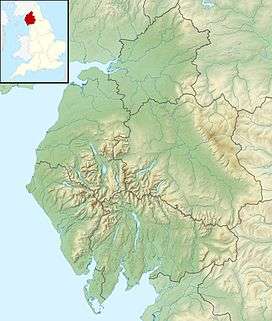Moorside Nuclear Power Station
| Moorside nuclear power station | |
|---|---|
 Location of Moorside nuclear power station in Cumbria | |
| Country | United Kingdom |
| Location | Sellafield, Cumbria |
| Coordinates | 54°25′46″N 3°30′39″W / 54.429566°N 3.510911°WCoordinates: 54°25′46″N 3°30′39″W / 54.429566°N 3.510911°W |
| Status | Proposed |
| Construction cost | £10 billion |
| Owner(s) | NuGen |
| Operator(s) | Engie |
| Nuclear power station | |
| Reactor type | AP1000 PWR |
| Reactor supplier | Westinghouse |
| Power generation | |
| Units planned | 3 |
| Nameplate capacity | 3,400 MW |
|
Website www.nugeneration.com/moorside.html | |
Moorside Nuclear Power Station is a proposal to build three AP1000 nuclear reactors on a site near Sellafield, in Cumbria, United Kingdom.[1] The plan by NuGeneration, which is the British subsidiary of Toshiba-owned Westinghouse Electric Company, has the station coming online from 2024 with 3.4GW of new nuclear capacity. Work up to 2018 would include acquiring the site licence, the development consent order, and other required permits and permissions to start work. Site preparation would take two years, up to 2020.[2]
History
In 2014, the Nuclear Decommissioning Authority agreed commercial terms with developer NuGen to extend a land option agreement to build three reactors at Moorside.[3] Later that year, HM Treasury agreed to provide financial security to investors in the project.[4]
In July 2015, NuGen purchased the land near Sellafield needed for the Moorside, approximately 200 hectares, for an undisclosed sum.[5]
In October 2016, National Grid announced proposals for consultation for a £2.8 billion project to connect the new plant to the national electricity grid. The proposal involves putting power-lines underground and under Morecambe Bay to reduce the impact on the Lake District National Park.[6]
AP1000 reactor design
The AP1000 is a nuclear power plant designed and sold by Westinghouse Electric Company. The plant is a pressurised water reactor (PWR) with improved use of passive nuclear safety. The design has fewer valves and pumps than previous PWRs and allows cooling without intervention for up to 72 hours, relying mostly on foolproof forces, like water flowing downhill and heat rising. This novel design has raised a number of concerns but the design has been approved for use in both the United States and China.
In December 2011, the Office for Nuclear Regulation (ONR) and Environment Agency (EA) issued interim design acceptance for the AP1000 reactor design. These indicated that there were 51 outstanding issues and the ONR and EA were satisfied with the plans to resolve these issues.[7] The issues include "Justification of novel form of structure for the steel/concrete composite walls and floors known as CA modules"[8]
Opposition
The proposal to build the station is opposed by Radiation Free Lakeland, a group of local activists.[9]
A report [10] commissioned by Radiation Free Lakeland[11] is critical of the AP1000 reactor design and has been written by the Edinburgh Energy and Environment Consultancy.[12] The report says that "The AP1000 reactor design is not fit for purpose and so should be refused a Design Acceptance Confirmation (DAC) and Statement of Design Acceptability (SDA)″.
Consultation
Stage 1 consultation took place between May and July 2015 and a report was published on 23 November 2015. Stage 2 consultation will take place between May and July 2016.[13]
Moorside landscape design competition
As part of the project’s future development, NuGen has decided to launch two international design competitions. One is for design concepts for the key buildings, open to architects; the other, open to landscape architects, is for design concepts for important elements and features of the landscape scheme, including significant earth bunds and mounds. The winning designs will go on to be developed as part of a future landscape masterplan, with the mounds forming an integral part of the setting of Moorside Power Station.
The mounds are very important factors in the design and development of the site. The construction of Moorside will involve deep excavations in order to reach suitable bedrock foundation conditions for the siting of the reactors. Together with excavation and levelling activities required to create a clear and level site, a large amount of earth will need to be moved around the Moorside ‘Search Area’ for these purposes, and used as part of both the temporary and permanent works such as flat construction laydown areas and screening mounds.
Efforts will be made to re-use as much excavated material as possible within the Moorside Search Area, subject to use suitability, visual impact and amenity (NuGen intends to make approximately 100ha of the 200ha site accessible to the public).
As part of its commitment to good design, NuGen is therefore looking for the most creative and sustainable design ideas for the screening mounds.
The Competition is hosted by NuGen and is run by the Landscape Institute.
To be eligible for the competition, entrants must be a chartered member of the Landscape Institute or a member of equivalent authority.[14]
References
- ↑ "The Moorside project". The Copeland Centre. Retrieved 2 May 2014.
- ↑ "First AP1000 at Moorside online by 2024, Westinghouse says". Nuclear Engineering International. Retrieved 2 May 2014.
- ↑ "NuGen progresses Moorside nuke plans". The Construction Index. Retrieved 2 May 2014.
- ↑ "New Cumbria nuclear plant moves another step forward". Press release from Department of Energy and Climate Change. gov.uk. Retrieved 18 December 2014.
- ↑ "NuGen acquires land for Moorside project". World Nuclear News. 14 July 2015. Retrieved 26 July 2015.
- ↑ "UK's National Grid updates plans for new nuclear plants". World Nuclear News. 25 October 2016. Retrieved 27 October 2016.
- ↑ http://www.onr.org.uk/new-reactors/ap1000/idac-isoda.htm
- ↑ http://www.onr.org.uk/new-reactors/ap1000/gda-issues-res-plan.htm
- ↑ Clarke, Andrew (27 September 2014). "Protest campaign launched against nuclear power station near Sellafield". News and Star. Carlisle. Retrieved 8 December 2014.
- ↑ http://www.theecologist.org/blogs_and_comments/commentators/2988356/ap1000_reactor_design_is_dangerous_and_not_fit_for_purpose.html
- ↑ http://www.newsandstar.co.uk/news/Moorside-reactors-too-great-a-risk-to-public-health-and-safety-report-claims-fed10206-dff5-40b0-a060-e085ef48204e-ds
- ↑ http://eee-consultancy.co.uk/
- ↑ "Step Two Consultation". Retrieved 4 July 2016.
- ↑ "Moorside Competition – Landscape Institute | Nugen". moorside.landscapeinstitute.org. Retrieved 2016-08-15.